
All Souls Unitarian Universalist Church, built in 1894 in the Richardsonian Romanesque style is an historic building located at 25 Church Street in Bellville, Ohio. On January 1, 1976, it was added to the National Register of Historic Places.

The First Universalist Church is a historic church building on the corner of Pleasant, Elm, and Spring Streets in Auburn, Maine. It was built in 1876 to a design by John Stevens of Boston, Massachusetts, and has been a significant landmark in the city since its construction. It is a fine local example of Gothic Revival architecture executed in brick, and was listed on the National Register of Historic Places in 1979.

The First Methodist Church in Monroe, Green County, Wisconsin, now the Monroe Arts Center, is a Gothic Revival edifice designed by the former Wisconsin State Architect E. Townsend Mix of Milwaukee and constructed of Cream City brick. It was commissioned in 1869 by the First Methodist Episcopal congregation of Monroe to replace an earlier church building that dated to 1843. The adjacent parsonage was completed in 1886, and the complete ensemble was finally dedicated in 1887.

The Union Church is a historic church on South Main Street in South Wolfeboro, New Hampshire. Built in 1845 for the use of several small religious congregations, it is a well-preserved example of mid-19th century vernacular Greek Revival architecture. The building was listed on the National Register of Historic Places in 1982.

The First Universalist Church, known locally as the Church on the Plains, is a historic church building on Main Street in Kingston, New Hampshire. Built in 1879 to a design by the regionally prominent architect C. Willis Damon, it is a fine local example of Stick/Eastlake architecture. It was listed on the National Register of Historic Places in 1979, and is now owned by the local historical society.
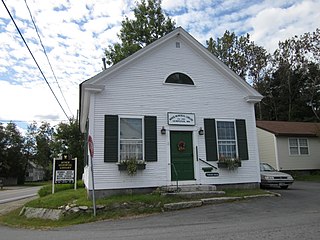
Miner Memorial Library is the public library of Lempster, New Hampshire, located at 3 Second New Hampshire Turnpike. The library occupies a single-story wood-frame structure built in 1845 as a church for a Universalist congregation. Despite significant alteration for its use as a library, the building remains a fine example of vernacular church architecture in Sullivan County. Under the name First Universalist Chapel, the building was listed on the National Register of Historic Places in December 2006, and the New Hampshire State Register of Historic Places in January 2006.

The Universalist Unitarian Church is a historic church on Silver Street and Elm Street in Waterville, Maine in the United States. Built in 1832 for a Universalist congregation founded in 1826, it is a prominent local example of transitional Federal-Gothic Revival architecture. It was listed on the National Register of Historic Places in 1978.

The First Universalist Church of Olmsted is a historic Unitarian Universalist church in the city of North Olmsted, Ohio, United States. The second-oldest church building in Cuyahoga County, it has been a community landmark since the middle of the nineteenth century, and it was officially named a historic site in the late twentieth.

The First Universalist Church in Elgin, Illinois was built in 1892. It was designed by George Hunter to resemble a pocket watch in Richardsonian Romanesque style. The church was listed on the National Register of Historic Places in 1980. It was subsequently included as a contributing property in the Elgin Historic District.
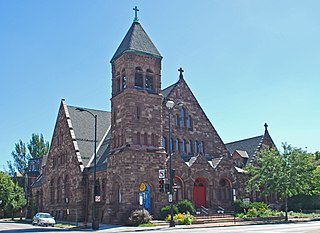
Church of the Epiphany is a historic Episcopal church located at 201 S. Ashland Avenue in Chicago, Illinois. The church was built in 1885 to replace its congregation's original church, which had grown too small for its increasing membership. Architect Francis M. Whitehouse of Chicago firm Burling and Whitehouse designed the church in the Richardsonian Romanesque style. The church has a sandstone exterior made up of irregularly coursed and roughly faced blocks; the stone was imported from Lake Superior. The building's entrances and windows are framed by heavy arches which are supported by short columns with floral decorations. A bell tower, completed in 1887, rises above the front corner of the church; the tower features patterned sections of smooth and rough stone and arched openings at the top.
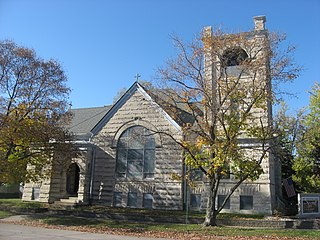
First Congregational Church is a historic Congregational church located at 202 N 6th Street in Marshall, Illinois. Built in 1909, the church was the third built for Marshall's First Congregation, which was established in 1841. The Gray Construction Company built the church in the Richardsonian Romanesque style. The church has limestone walls laid in alternating smooth and rusticated rows. The asymmetrical entrance features two arches supported by columns with ornamental floral capitals. The church has multiple stained glass windows, including a rose window on its front facade. A 56-foot (17 m) bell tower with square pillars at the upper corners marks the southeast corner of the building. The tower's bell, a relic from the original two churches, was made in 1850 by the Buckeye Bell Foundry of Cincinnati, Ohio.

The First Unitarian Church of Marietta is a historic Unitarian Universalist church in the city of Marietta, Ohio, United States. Founded in 1869, it uses a building constructed in 1858 for one of its two predecessor churches; this building's high-quality architecture has led to its designation as a historic site.
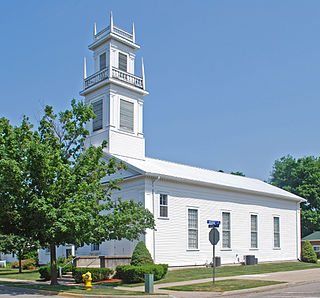
The Portland First Congregational Church is a historic church located at 421 E. Bridge Street in Portland, Michigan. The original Greek Revival style church was built in 1853 and added to the National Register of Historic Places in 1984. In 2015, the church was demolished by a tornado; it was rebuilt in 2016 in a style true to the original.
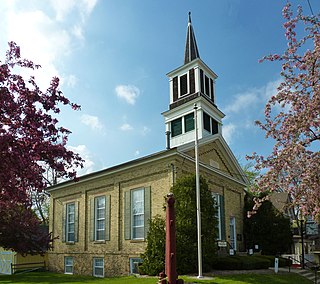
The Stoughton Universalist Church is a Greek Revival-styled church built in Stoughton, Wisconsin in 1858. It was added to the National Register of Historic Places in 1982.

The Bradford Community Church, originally the Henry M. Simmons Memorial Church and later the Boys and Girls Library, is a historic church built in 1907 in Kenosha, Wisconsin, United States under the leadership of Kenosha's first woman pastor.

The Highland Avenue Methodist Church in Milwaukee, Wisconsin is a Gothic Revival-styled church built in 1891 by Milwaukee's first German Methodist congregation. It was added to the National Register of Historic Places in 1986.

Unity Church, now known as Trinity Episcopal Church, is a historic church located at 2200 Western Avenue in Mattoon, Illinois. Mattoon's Unitarian congregation built the church in 1872. The church was built with red brick with stone decorations and a wooden cornice. A rectangular bell tower stands at the church's southeast corner; the tower is louvered and contains two bells. The church's main entrance is located at the bottom of the tower. The church's nave is on the south side of the church; the nave features a wheel window and a large stained glass window with a wheel and two arches. The top of the nave and bell tower is decorated with corbelled brickwork. Mattoon's Unitarian congregation disbanded in the 1900s, and the church is now occupied by an Episcopal congregation

The Union Meetinghouse or Universalist Church is a historic church building at 97 Amesbury Road in Kensington, New Hampshire. Built in 1839-40, it is a well-preserved and little-altered example of a mid-19th century Greek Revival rural church. It was listed on the National Register of Historic Places in 2013, and continues to be used for summer services.

Harmony Hall is a historic religious and civic building at 24 Kennebec Road in Hampden, Maine. Built in 1829 as a Universalist church and restyled in 1896, it is a fine example of Greek Revival and Gothic Revival architecture, with a long history as a site for community events. It was listed on the National Register of Historic Places in 2007.

The Jerseyville First Presbyterian Church is a historic Presbyterian church at 400 South State Street in Jerseyville, Illinois. The church was built in 1882 to replace Jerseyville's Presbyterian congregation's original church, which had been built on the same site in 1841. The congregation itself formed in 1834, making it the first church of any sort in the county. Architect James Roland Willett of Chicago designed the church in the High Victorian Gothic style, which was commonly used for rural religious buildings at the time. The church has a limestone exterior built with stone from nearby Grafton, and its design includes a corner bell tower with a steeple, pointed arch windows and doors, and a complex roof with a front-facing gable.






















